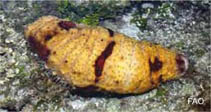Actinopyga agassizi Selenka, 1867
Five-toothed sea cucumberWarning: DOMDocument::load(): SSL operation failed with code 1. OpenSSL Error messages: error:140770FC:SSL routines:SSL23_GET_SERVER_HELLO:unknown protocol in C:\Apache24\htdocs\includes\SpeciesSummary.lib.php on line 1236
Warning: DOMDocument::load(): Failed to enable crypto in C:\Apache24\htdocs\includes\SpeciesSummary.lib.php on line 1236
Warning: DOMDocument::load(https://sealifebase.nrm.se/webservice/AquaMaps/getAMap.php?genus=Actinopyga&species=agassizi): failed to open stream: operation failed in C:\Apache24\htdocs\includes\SpeciesSummary.lib.php on line 1236
Warning: DOMDocument::load(): I/O warning : failed to load external entity "https://sealifebase.nrm.se/webservice/AquaMaps/getAMap.php?genus=Actinopyga&species=agassizi" in C:\Apache24\htdocs\includes\SpeciesSummary.lib.php on line 1236
Classification / Names Common names | Synonyms | CoL | ITIS | WoRMS
| Holothuriida | Holothuriidae
Environment: milieu / climate zone / depth range / distribution range Ecología
; rango de profundidad 0 - 54 m (Ref. 83942). Tropical
Distribución Países | Áreas FAO | Ecosistemas | Ocurrencias, apariciones | Introducciones
Western Atlantic: Gulf of Mexico and the Caribbean.
Length at first maturity / Tamaño / Peso / Age
Maturity: Lm ? range ? - ? cm Max length : 35.0 cm TL macho / no sexado; (Ref. 624)
A coastal and nocturnal species. Forages on algal turf, seagrass meadows, and in rubble or sand covered areas (Ref. 485). This is an epibenthic, subtidal species found in coral reefs, seagrass and rocky bottoms (Ref. 83942). Nocturnal. Forages on algal turf, seagrass meadows, and in rubble or sand covered areas (Ref. 485).
Life cycle and mating behavior Madurez | Reproducción | Puesta | Huevos | Fecundidad | Larva
Members of the class Holothuroidea are gonochoric and have only one gonad. Spawning and fertilization are both external and some exhibit brooding. Life cycle: Embryos develop into planktotrophic larvae (auricularia) then into doliolaria (barrel-shaped stage) which later metamorphose into juvenile sea cucumbers.
Main reference
Referencias | Coordinador | Colaboradores
Hasbún, C.R. and A.J. Lawrence. 2002. (Ref. 624)
IUCN Red List Status (Ref. 130435)
Least Concern (LC) ; Date assessed: 18 May 2010
CITES status (Ref. 108899)
Not Evaluated
CMS (Ref. 116361)
Not Evaluated
Threat to humans
Human uses
| FishSource |
Herramientas
Más información
Países
Áreas FAO
Ecosistemas
Ocurrencias, apariciones
Introducciones
Stocks
Ecología
Dieta
componentes alimenticios
Áreas FAO
Ecosistemas
Ocurrencias, apariciones
Introducciones
Stocks
Ecología
Dieta
componentes alimenticios
Fuentes de Internet
BHL | BOLD Systems | CISTI | DiscoverLife | FAO(Publication : search) | Fishipedia | GenBank (genome, nucleotide) | GloBI | Gomexsi | Google Books | Google Scholar | Google | PubMed | Árbol de la vida | Wikipedia (Go, búsqueda) | Expediente Zoológico
Estimates based on models
Preferred temperature
(Ref. 115969): 24.9 - 28, mean 27 (based on 206 cells).
Price category
(Ref. 80766):
Unknown.



